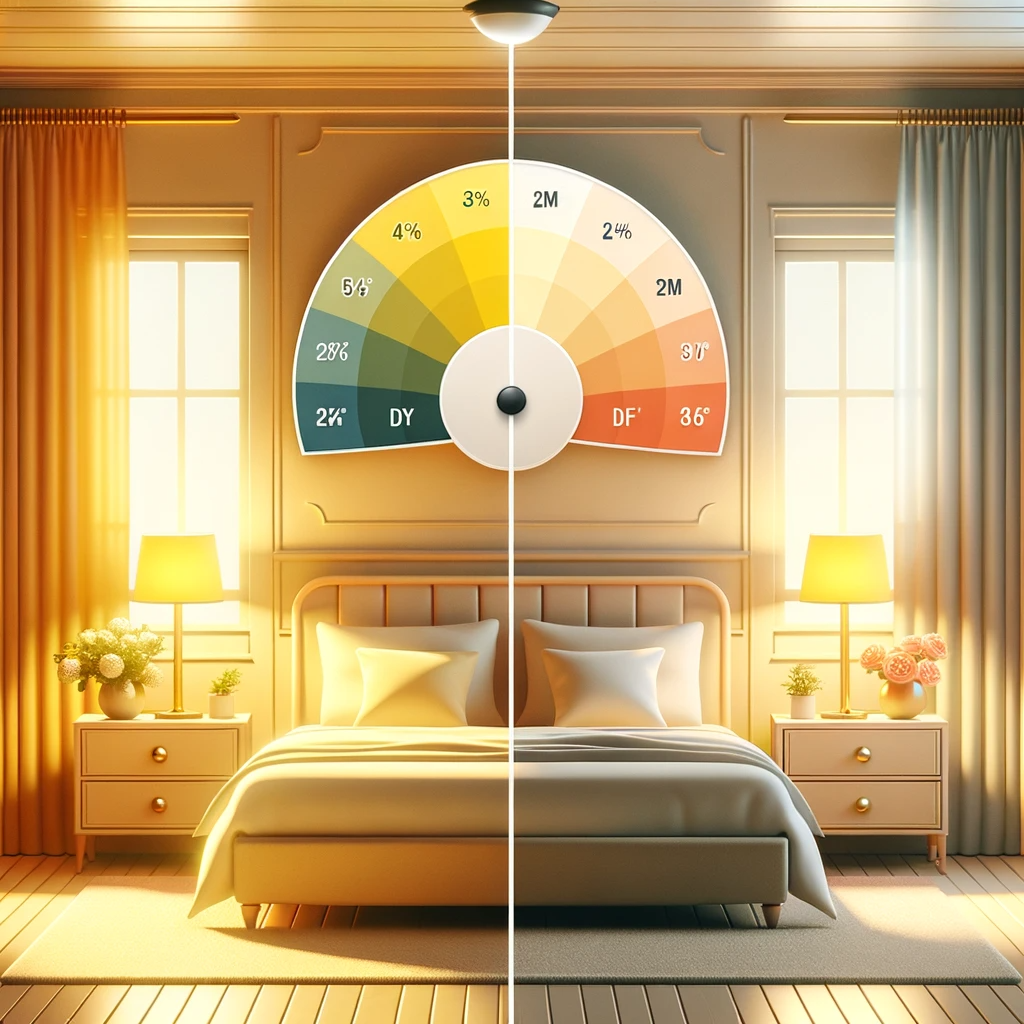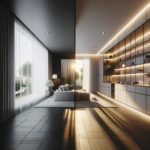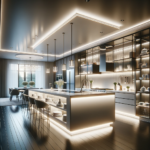Introduction to Color Temperature

Color temperature is a vital aspect of indoor lighting that significantly impacts the overall atmosphere and mood of a space. The color temperature of light is measured on the Kelvin scale, which ranges from warm to cool tones. Understanding color temperature is crucial for creating the desired ambiance and achieving optimal functionality in different indoor environments.
Definition and Importance of Color Temperature in Indoor Lighting

The term “color temperature” refers to the perceived warmth or coolness of light emitted by a light source. It is determined by the color of light produced when an object is heated to a specific temperature, expressed in Kelvin (K).
Higher temperatures produce cooler, bluish tones, while lower temperatures result in warmer, reddish hues. The importance of color temperature lies in its ability to evoke specific emotions and influence human behavior.
Warm colors (typically ranging from 2000K to 3000K) create a cozy and intimate atmosphere suitable for relaxation or social settings. In contrast, cool colors (5000K and above) emit bright, energetic light that stimulates productivity and focus—ideal for working or active spaces.
How Color Temperature Affects the Mood and Ambiance of a Space
Color temperature plays a vital role in setting the right mood for any given environment. Warm lighting with lower color temperatures creates a sense of comfort, tranquility, and warmth – perfect for bedrooms or living rooms where relaxation is key.
On the other hand, cooler lighting with higher color temperatures promotes alertness, concentration, productivity – making it suitable for offices or study areas. Moreover, color temperature influences how objects appear under different lighting conditions due to its impact on our perception of colors.
For instance, warm lighting can enhance warm-colored surfaces like wood furnishings or earth-toned walls while slightly muting cooler hues like blues or greens.
Basics of Color Temperature

Explanation of the Kelvin scale used to measure color temperature
The Kelvin scale is a unit of measurement used to quantify color temperature in lighting. It measures the hue of light emitted by a light source, ranging from warm to cool tones. The scale starts at absolute zero and goes infinitely upwards.
In lighting, it typically ranges from 1000K to 10000K. The higher the Kelvin value, the cooler or bluer the light appears, while lower values indicate warmer or more yellowish light.
Different color temperatures and their corresponding characteristics:
Warm colors (2000-3000K): These temperatures create a cozy, intimate, and relaxing atmosphere. They mimic the warmth of candlelight or sunrise/sunset glow.
Warm white lighting is often preferred for spaces where comfort and relaxation are desired, like bedrooms or living rooms. Neutral colors (3500-4500K): Neutral color temperatures provide natural-looking illumination that closely resembles daylight.
They offer balanced lighting with no significant presence of warm or cool tones. This range is versatile and suitable for various indoor settings such as offices, kitchens, and bathrooms.
Cool colors (5000K and above): Cool color temperatures emit bright white light with blue undertones. They create an energetic and stimulating environment that promotes alertness and focus.
This range is commonly used in commercial spaces like schools, hospitals, retail stores, or offices where productivity is key. Understanding these different color temperatures allows you to choose lighting that aligns with your desired atmosphere for any given space – whether you want a cozy and intimate feel or a bright and energizing ambiance.
Understanding the Science Behind Color Temperature
The Relationship between Color Temperature and Light Source Temperature
Color temperature is closely related to the temperature at which a light source operates. Different light sources emit various wavelengths that determine their color temperature.
The color of light is determined by the amount of energy carried by its photons. As the temperature of a light source increases, its color temperature also rises.
For example, incandescent bulbs have a filament that heats up when electricity passes through it, emitting a warm yellowish light with a lower color temperature. On the other hand, fluorescent lights use excited gas to emit ultraviolet radiation that stimulates phosphors on their inner coating to produce visible light with a cooler color temperature.
How Different Light Sources Emit Various Wavelengths That Determine Their Color Temperature
Light sources emit different wavelengths within the visible spectrum, leading to variations in their color appearance and perceived warmth. When an object is heated or energized, it radiates energy in different colors based on its temperature.
This concept is represented using Kelvin (K) scale for measuring color temperatures. Lower Kelvin values indicate warmer colors such as red or yellow hues associated with fire or candlelight.
Higher Kelvin values indicate cooler colors such as blue hues associated with daylight or overcast skies. It’s important to note that color temperatures don’t necessarily reflect the visible colors emitted by an object but rather how we perceive those colors based on their correlation with specific temperatures.
Applications of Different Color Temperatures in Indoor Lighting
Residential Spaces
Bedrooms: Optimal Warm Lighting for Relaxation and Sleep Quality Enhancement
Warm lighting with a color temperature between 2000K-3000K creates a cozy and intimate atmosphere in bedrooms. This soft, golden-hued light helps relax the mind and body, promoting better sleep quality.
The warm glow mimics the natural light of sunset, signaling to our bodies that it is time to unwind and prepare for rest. It also adds a touch of warmth and comfort to the space, making it feel more inviting and soothing.
Living Rooms: Balancing Warm and Neutral Lighting for Comfort and Versatility
In living rooms, striking a balance between warm and neutral lighting is ideal to achieve both comfort and versatility. Warm lighting can be used to create a cozy ambiance during evening relaxation or social gatherings. It brings out the warmth in furniture, artwork, and décor elements.
However, incorporating some neutral lighting with a color temperature ranging from 3500K-4500K ensures good visibility for activities like reading or working on hobbies without straining the eyes. This combination allows for different moods within the living space while maintaining functionality.
Commercial Spaces
Office Spaces: Cool White Lighting for Increased Productivity and Focus
Office spaces benefit from cool white lighting with color temperatures above 5000K as it promotes alertness, concentration, and productivity. This bright white light simulates daylight conditions that help keep employees mentally stimulated throughout the day. The high color temperature reduces eye strain by providing sufficient illumination for tasks such as reading documents or working on computers.
Restaurants: Warm or Neutral Lighting to Create a Welcoming Ambiance
For restaurants aiming to create an inviting and cozy atmosphere, warm or neutral lighting is key. Warm lighting, with its soft and relaxing glow, enhances the dining experience by creating a sense of intimacy. It adds warmth to the décor and complements food presentation, making dishes appear more appealing.
On the other hand, neutral lighting ensures that colors are accurately represented and allows customers to see menus clearly. By striking the right balance between warmth and neutrality, restaurants can create a welcoming ambiance that entices patrons to enjoy their meals in a comfortable setting.
Advanced Concepts Related to Color Temperature
Exploring the Impact of CRI on Color Perception
CRI (Color Rendering Index) significantly influences our perception of colors when illuminated by different light sources. Light sources with a high CRI value, typically above 80, accurately reveal the true colors of objects and surfaces. This is achieved by producing a broad spectrum of light that closely resembles natural daylight.
In contrast, light sources with a low CRI value can distort colors, making them appear dull, washed out, or even completely different. For activities that require accurate color representation, such as art studios or retail spaces showcasing products, it’s crucial to choose lighting with a high CRI.
The Dynamic World of Tunable White Lighting
Tunable white lighting is an innovative concept that allows for the dynamic adjustment of color temperature based on time or activity. By utilizing advanced controls and smart lighting systems, this technology enables spaces to transition seamlessly between warm and cool lighting throughout the day.
The benefits are multifaceted: during mornings and evenings when relaxation is desired, warmer color temperatures create a cozy ambiance conducive to winding down. Conversely, in spaces where focus and productivity are essential during daytime hours, cooler color temperatures can promote alertness and mental acuity.
Tunable white lighting finds applications in various settings such as offices that cater to different tasks throughout the day or healthcare environments where patient comfort and staff efficiency are priorities. This flexibility provides users with greater control over their environment while positively influencing mood and well-being.
Tips for Choosing the Right Color Temperature
Considering the purpose of the space when selecting a specific color temperature.
Consider the intended function of the space before deciding on a color temperature. Determine whether the space requires a warm, neutral, or cool lighting ambiance.
For example, in a bedroom where relaxation and sleep are paramount, opt for a warm color temperature (around 2000-3000K) to create a cozy and calming atmosphere. Conversely, in an office space where productivity is key, choose a cooler white light (around 5000K) to promote alertness and focus.
Experimenting with different combinations of light sources.
To achieve optimal lighting results, experiment with different combinations of light sources. Mix and match various bulbs or fixtures with different color temperatures to create layers of light that suit your needs. For instance, in a living room that serves both as an entertainment area and reading nook, you can use warm lighting (around 2700K) for general illumination while incorporating task lighting with cooler white bulbs (around 4000K) near seating areas or bookshelves.
Conclusion
Understanding color temperature in indoor lighting is crucial for creating the desired ambiance and functionality within a space.
By considering the purpose of each area when selecting color temperatures and experimenting with different light source combinations, you can effectively tailor your lighting to meet specific needs. Whether it’s creating a cozy retreat in your bedroom or fostering productivity in your workspace, finding the right balance through thoughtful consideration and experimentation will enhance your overall experience.
Embracing this knowledge empowers you to transform any environment into one that not only looks visually appealing but also positively influences mood and well-being. So go ahead – embrace the world of color temperature possibilities!









